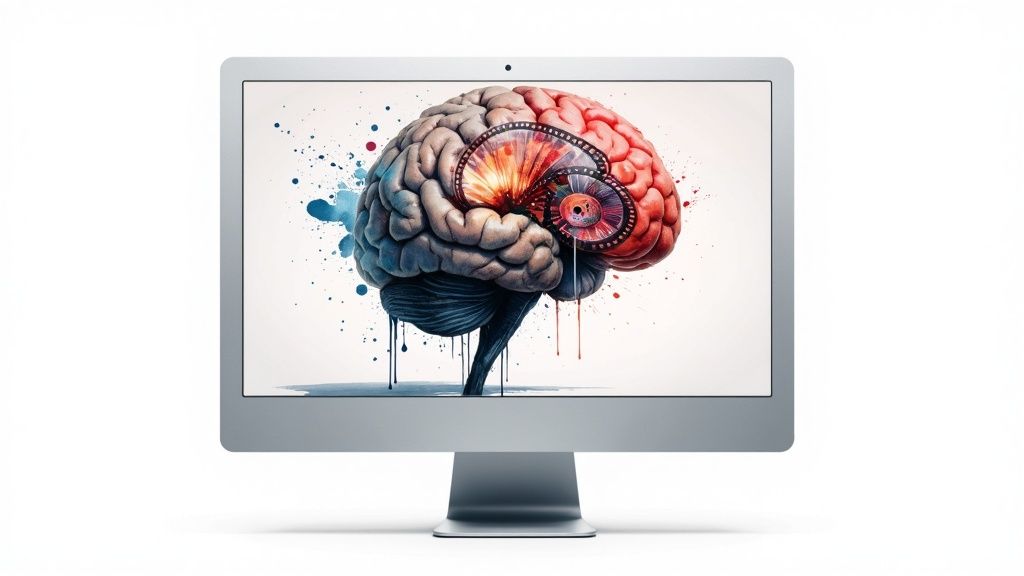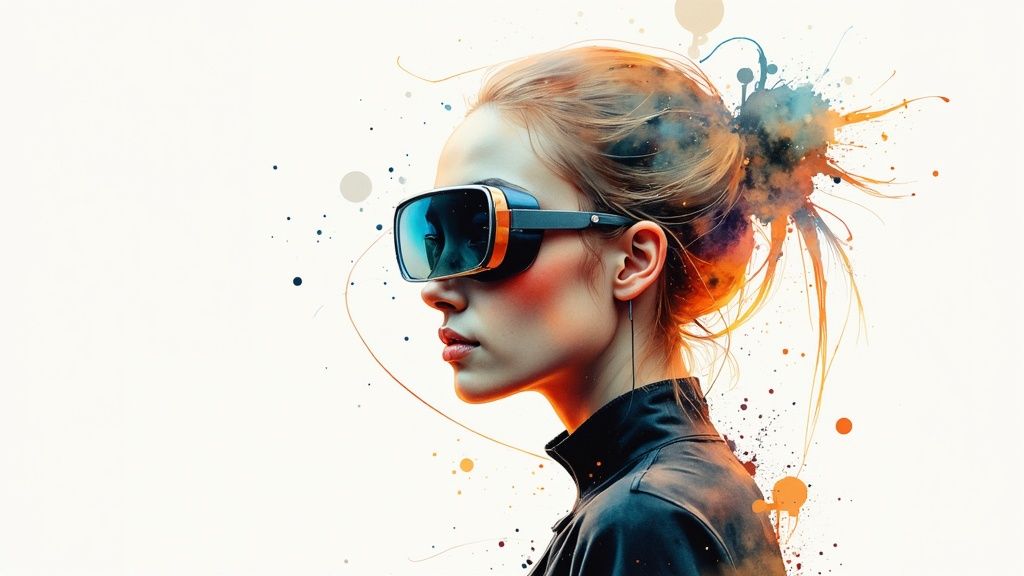Demystifying AI Video Generation: What Actually Works

AI video generation is changing how we create and consume video. It's not simply about automating tedious tasks. It's about opening up new creative avenues. Imagine turning a short text prompt into a full video, complete with visuals, music, and voiceovers. This is the potential of AI video generation. It's increasingly available to everyone, regardless of their skill level.
Core Technologies Powering AI Video Generation
Several technologies are driving this change in video creation. Understanding these fundamentals is key to using these tools effectively and staying ahead. Knowing the strengths and weaknesses of each technology helps creators make smart choices for their video production.
To illustrate these core technologies, let's examine a comparison table:
To help understand the core technologies driving AI video generation, the following table summarizes their primary functions, common use cases, and potential limitations.
Core AI Video Generation Technologies A practical comparison of technologies powering today's most effective AI video tools
| Technology | Primary Function | Use Cases | Limitations |
|---|---|---|---|
| Neural Networks | Mimic the human brain to learn patterns from data. | Generating realistic images and videos, analyzing existing video content. | Requires massive datasets for training, can be computationally expensive. |
| Generative Algorithms | Create new content based on learned patterns. | Synthesizing videos from text prompts, creating variations of existing videos. | Output quality can be unpredictable, may require fine-tuning for specific styles. |
| Natural Language Processing (NLP) | Enables AI to understand and interpret human language. | Converting text scripts into video scenes, generating voiceovers from text. | Can struggle with nuanced language or complex narratives. |
This table summarizes the key technologies behind today's AI video tools. As you can see, each technology plays a vital role in bringing AI-generated videos to life.
The Growing Market for AI Video Generation
This technological growth is reflected in the expanding AI video generation market. The global market, valued at about USD 555 million in 2023, is projected to reach nearly USD 2 billion by 2030. This shows a CAGR of almost 20%. This rapid growth underscores the rising need for engaging video content and the increasing use of AI tools to create it. Find more data here: https://www.grandviewresearch.com/horizon/outlook/ai-video-generator-market-size/global
Integrating AI into Video Production
While AI video generation presents new opportunities, understanding effective video production for marketing remains essential. This ensures AI-generated content aligns with overall marketing goals and maintains quality. Combining AI with human creativity produces results that are efficient and impactful. This blended approach utilizes the strengths of both AI and human input, creating engaging, high-quality video content.
Finding Your Perfect AI Video Tool: Beyond the Hype

The AI video generation scene is booming with options. Picking the right tool can feel like navigating a maze. But by zeroing in on your needs and grasping the core strengths of each platform, you can make a smart choice. It's all about finding a tool that boosts your creativity, not holds it back.
Key Features to Consider
What separates the truly effective AI video tools from the rest? Here are the key features to weigh when making your decision:
-
Input Methods: Does the tool handle text-to-video, image-to-video, or both? Some even offer video-to-video editing. This flexibility is key for diverse creative projects.
-
Customization Options: How much control do you have over the visuals, music, voiceovers, and pacing? Robust customization is crucial for creating unique, on-brand videos.
-
Output Quality: Will the tool deliver high-resolution videos suitable for your target platforms? Look for tools offering HD and 4K output.
-
Ease of Use: Is the platform intuitive and easy to learn, regardless of your tech skills? A user-friendly interface saves time and headaches.
-
Integration Capabilities: Does it play well with other platforms you use, like social media or video editing software? Seamless integration streamlines your workflow.
-
Pricing: Does the pricing structure fit your budget and expected usage? Explore different tiers to find the sweet spot.
Matching Tools to Your Needs
Different AI video tools shine in different areas. Some are perfect for short, snappy social media content, while others handle longer, more intricate videos with ease. For example, Veo, mentioned in recent Google announcements, offers advanced image-to-video features – ideal for repurposing existing visual assets. Other platforms focus on text-prompted video generation, with varying levels of customization. Find the tool that aligns with your project's scope.
To help you navigate the options, we've compiled a comparison of leading AI video generation tools. This table highlights the key features, pricing models, and output quality of each platform to help you find the perfect fit for your video creation needs.
AI Video Generation Tools That Deliver Results Straightforward comparison of leading tools based on real-world performance and value
| Tool Name | Best For | Key Features | Pricing Model | Output Quality Rating |
|---|---|---|---|---|
| Veo | Image-to-video conversion, sports analysis | Advanced AI-powered tracking and analysis, automated highlights | Subscription-based | High |
| Synthesia | Creating personalized videos with AI avatars | Wide range of avatars, realistic voiceovers, support for multiple languages | Subscription-based | High |
| Pictory AI | Creating short-form videos from long-form content | Automatic video transcription, AI-powered editing, easy sharing to social media | Subscription-based | Medium |
| Runway ML | Creative video editing and effects | Powerful AI tools for generating visual effects, collaborative features | Subscription-based | High |
| InVideo | Creating marketing and explainer videos | Wide selection of templates, drag-and-drop interface, music library | Subscription-based | Medium |
This table offers a concise overview of some prominent AI video generation tools. As you can see, each tool caters to slightly different needs, highlighting the importance of researching the specific capabilities of each platform before making a decision.
Beyond the Basics: Hidden Capabilities
Some AI video tools pack features that go beyond the standard offerings. These hidden gems can be game-changers for your creative workflow. Look for tools with advanced editing features like AI-powered trimming or easy text overlays. This gives you finer control over the final product. Some platforms even let you train the AI on your brand's unique style for more consistent results. These extras can give you a real competitive advantage.
Choosing the right AI video tool takes careful thought. By understanding the key features and hidden capabilities, you can cut through the noise and pick a tool that truly empowers your video creation process. This lets you focus on the creative side, while the AI handles the technical heavy lifting. The best tool is the one that helps you bring your specific vision to life.
Transforming Your Video Workflow With AI Integration

Smart creators are weaving AI video generation into their workflows. This isn't about replacing human creativity; it's about enhancing it. By combining AI with human expertise, production teams are achieving impressive results. This involves understanding AI's strengths and where human input remains essential.
Identifying Areas for AI Automation
Some video production tasks are perfect for automation. Repetitive jobs, like basic animations or creating different versions of footage, can be efficiently handled by AI. This allows human creators to focus on tasks requiring strategic thinking and artistic vision. For example, AI can quickly create multiple social media video versions, each tailored to a specific platform.
Balancing AI and Human Creativity
AI isn't a cure-all. It still struggles with nuanced storytelling and complex emotions. The key is a hybrid approach, combining the strengths of both AI and human creators. Think of AI as a powerful tool handling technical work, while humans maintain creative control and ensure the final product connects with the audience. Read also: How to create video ads that convert.
Adapting Roles and Processes
AI is changing creative team roles. Video editors are becoming AI workflow specialists, managing AI tools and ensuring smooth human-machine collaboration. New roles are also emerging, like prompt engineers, who specialize in writing effective instructions for AI video tools. Traditional workflows need to adapt to these changes.
The Growing Impact of AI on Video Production
This shift is significantly impacting the industry. The AI video generator/editor market, valued at about $0.6 billion in 2023, is projected to reach $9.3 billion by 2033, a CAGR of 30.7%. This growth reflects the increasing demand for video and AI adoption. Challenges remain, such as high implementation costs, but AI advancements open exciting new opportunities. Find more detailed statistics here. The popularity of short-form video platforms drives this trend further, as businesses seek efficient ways to create many targeted videos. This highlights AI's potential to change video production, helping creators work smarter, not harder. By embracing AI and adapting workflows, creative teams can thrive in the evolving video content world.
Crafting AI Video Prompts That Actually Work

The quality of AI-generated videos depends heavily on how well you communicate with the AI. This means creating prompts that are both precise and descriptive. This section explores prompt engineering techniques that consistently deliver impressive results. We’ll look at the language, strategies, and iterative process involved in crafting effective prompts.
Mastering the Art of Prompting
Imagine an AI video generator as a highly skilled artist needing clear instructions. Vague directions will lead to unpredictable results. However, specific, detailed prompts will guide the AI towards the video you envision. Precision is the key to unlocking the true power of AI video generation.
Here’s how to write effective prompts:
-
Be Specific: Instead of “a cat,” try “a fluffy orange tabby cat sitting on a windowsill, bathed in sunlight.” Detail is crucial.
-
Define the Style: Specify the desired visual aesthetic. Do you want a realistic, cartoonish, or cinematic look? Try descriptions like “watercolor style” or “film noir lighting.”
-
Describe the Action: Clearly outline the video’s narrative or movement. Instead of “a bird flying,” try “a hawk soaring through a canyon, diving towards its prey.”
-
Set the Mood: Use descriptive words to set the emotional tone. Words like “joyful,” “eerie,” or “intense” can guide the AI towards the feeling you want to evoke.
Refining Your Prompts: An Iterative Process
Your first prompt rarely produces the perfect video. Iteration is essential. Begin with a basic prompt and then refine it based on the AI’s output. This ongoing process of experimentation and refinement helps you understand how the AI interprets your instructions. When crafting prompts, also consider tools that help refine raw video output, such as those with video trimming capabilities.
Building Your Prompt Library
As you experiment, save your successful prompts. This creates a personal library of effective prompts for future use, saving time and ensuring quality. Categorize your prompts based on style, subject, or mood.
Prompt Examples for Different Scenarios
Let’s look at practical examples. For a product demo, a good prompt might be: “A sleek, modern smartphone rotating 360 degrees, showcasing its features, against a clean white background.” For social media, consider: “A fast-paced montage of exciting travel moments, set to upbeat music, with text overlays highlighting key locations.” These examples demonstrate the importance of tailoring the prompt to the context. For more information on text overlays, check out this guide on how to master text overlays in your videos.
By mastering prompt engineering, you transform AI video generation from a random process into a powerful tool. This control and precision unlock the full creative potential of AI, empowering you to create high-quality, engaging video content.
Navigating the Ethical Maze of AI Video Creation
AI video generation offers incredible creative potential. However, it also presents ethical dilemmas that content creators must carefully consider. Responsible use requires us to think beyond the technology itself and examine its broader impact on copyright, potential manipulation, representation, and creative ownership.
Copyright Concerns in AI-Generated Videos
AI video tools learn by analyzing massive datasets of existing content. This immediately raises questions about copyright infringement. Even unintentional use of copyrighted material can lead to legal problems. Imagine an AI generating a video eerily similar to a copyrighted film clip. This could easily be seen as a copyright violation.
Addressing Manipulation and Misinformation
AI can create shockingly realistic videos. This power can be exploited to create deepfakes or spread misinformation. These manipulated videos can severely damage reputations and erode trust. It’s crucial for creators to understand these risks and work actively to prevent such misuse.
Representation and Bias in AI Video Generation
AI models learn from data, and data can reflect societal biases. Consequently, AI-generated videos may perpetuate stereotypes or underrepresent certain groups. For example, if training data primarily features one ethnicity, the AI might struggle to generate videos representing a diversity of people. This highlights the importance of diverse and inclusive training data.
Creative Attribution and Transparency
Determining copyright for AI-generated videos is a complex issue. Who owns the copyright – the person who provides the prompt, the company behind the AI tool, or the original data owners? There are no easy answers. Transparency is paramount. Openly disclosing the use of AI builds trust with the audience.
Practical Steps for Ethical AI Video Generation
How can creators navigate these ethical challenges? Here are some practical tips:
- Understand the AI tool’s limitations: Know its capabilities and avoid using it for ethically ambiguous purposes.
- Use disclaimers: Clearly label AI-generated videos.
- Review generated content carefully: Check for copyright issues, misrepresentations, or harmful content before publishing.
- Develop personal ethical guidelines: Establish clear boundaries for your own AI usage.
- Stay informed: Keep up-to-date on best practices and legal developments in AI video generation.
By thoughtfully addressing these ethical considerations, creators can use the power of AI video generation responsibly. This involves continuous learning and adaptation. As AI develops, our ethical awareness must also evolve. By staying informed and acting responsibly, we can ensure AI video generation becomes a positive force for creativity.
The Future of AI Video: Opportunities You Can't Ignore
The AI video generation field is constantly changing. Staying ahead means understanding developing trends and planning strategically. This involves anticipating how advancements will influence video creation and finding opportunities for early adoption. By exploring these future possibilities, you can integrate these powerful tools into your content strategy.
Enhanced Motion Coherence and Realism
A key area of improvement is motion coherence. Current AI videos sometimes have jerky or unnatural movements. Future advancements will address this, creating smoother, more realistic motion. This improved realism will make AI videos virtually identical to traditionally filmed footage. Imagine AI easily producing complex action scenes or subtle animations with flawless flow.
Emotional Rendering and Character Depth
Beyond just physical realism, AI is improving in how it portrays emotions. Future tools may be able to render nuanced facial expressions and body language, adding emotional depth to characters. This opens exciting doors for storytelling and character-driven narratives within AI-generated videos. Imagine creating a moving story told entirely through AI characters expressing genuine emotion.
Interactive and Personalized Video Experiences
AI video generation isn't just about passive consumption. The future points toward interactive video experiences. Imagine videos that respond to viewer input, offering personalized storylines or product demonstrations tailored to individual preferences. This interactivity creates immersive experiences and new possibilities for audience engagement.
Sector-Specific Disruption and Opportunities
Certain sectors are ripe for disruption by AI video generation. E-commerce, for instance, could see a rise in personalized product videos for individual shoppers. Education may benefit from adaptable learning materials. Entertainment could see new forms of interactive storytelling and personalized gaming. Identifying these sector-specific opportunities is crucial for staying ahead. Google, for example, recently announced Veo, an AI model that generates videos from text and image prompts. Platforms like Veo are pushing the boundaries of video creation. More information on Veo is available here.
Strategies for Staying Ahead of the Curve
Successfully navigating the future of AI video requires a balanced approach. While it's essential to be aware of new tools, avoid blindly following every trend. Focus on technologies that align with your long-term goals and integrate them strategically. For example, invest time in learning prompt engineering to improve the quality of your current AI video output. Stay informed about advancements, but prioritize tools offering tangible benefits for your specific needs.
Preparing for the Future of Video Creation
The future of AI video is full of potential. By understanding emerging trends and having a clear vision, you can capitalize on these opportunities. This involves staying informed, experimenting with new tools, and focusing on ethical implementation. The goal is to adapt and innovate, ensuring AI enhances human creativity. This enables you to use AI's full potential to create compelling video content.
Ready to transform your video process? Explore Aeon, the video creation platform built for publishers.